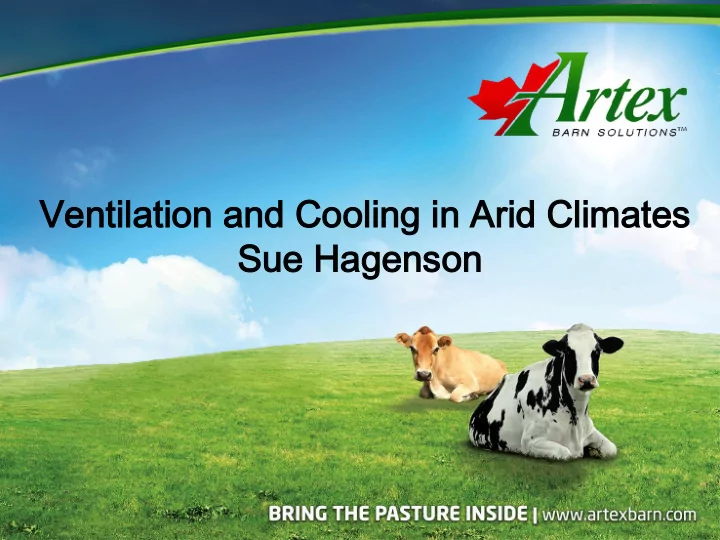

Ve Vent ntil ilat ation ion an and Co d Cool olin ing in Ar g in Arid id Cl Clim imat ates es Su Sue Ha e Hage gens nson on
Heat at St Stress ess Costs sts to to Dairy iry Pr Producers oducers • Dairy Producers strive to achieve consistently high milk production, feed efficiency and reproductive efficiency while maintaining the health of the dairy animal • Dairy Cattle are sensitive to heat stress on account of the high metabolic heat production during feed intake – rumen fermentation and milk yield • Heat stress characterised by increased rectal temperature, elevated respiration rate, decreased feed intakes which subsequently decreases milk yield • Heat stress has a negative impact on a dairy farm’s future by reducing the peak milk production of cows which go through the transition periods of heat stress
Wh When en are e Animals mals in Heat at Str tress ess For lactating cows, temperatures above 23.9C start to have an impact
Wh When en are e Animals mals in Heat at Str tress ess Mild Heat Stress Moderate Heat Stress Severe Heat Stress Dangerous Heat Stress Measures Temperature & Humidity Doesn’t Measure Radiant Heat Load under the roof & the Heat the Cow Generates
How w to to Keep ep Cows ws Cool ol Kn Know ow you our En Enviro ironment nment • More dairy farms being constructed throughout the world producers need to select carefully the appropriate facility for the local climate • Facility options vary depending on the severity of heat stress capital costs to construct a dairy farm will vary considerably based on the environmental conditions present • In more sever climates greater effort is required to properly cool cows
How w to to Keep ep Cows ws Cool ol Kn Know ow you our En Enviro ironment nment B = Arid BWh W = Desert h = Hot Arid
How w to to Keep ep Cows ws Cool ol Str trateg ategy y to to red educ uce e th the Im e Impa pact ct of of Hea eat • Two Main Strategies 1. Reducing the heat load on dairy animals 2. Maximising heat loss from dairy cows • Tools needed to reduce the heat load is; 1. Shade to reduce the solar heat load 2. Cooling to reduce the air and cow temperature and increases thermal gradient for cows to dissipate heat from the skin surface 3. Fans to increase convective air movement across the skin surface and increase convective heat loss • Strategies for all buildings/class of animal need to be addressed
How w to to Keep ep Cows ws Cool ol Wat ater er • Should be made available to cows • Water at the parlour – lactating cows will consume 10% of their daily intake if given the chance at the parlour Water space in the barn ~ 3-9 linear cm per cow •
How w to to Keep ep Cows ws Cool ol Sha hade de Shade • Adequate shade in the housing area and the parlour • Shade should be constructed at a height of at least 4.3m and ideally a 4/12 pitch • Using porous materials such as shade cloth is not as effective as solid shades
How w to to Keep ep Cows ws Cool ol Bar arn n Ori rien entation tation • Barns with a north-south orientation have a greater solar radiation exposure than barns with an east-west. • Cows seek shade during the summer protection from direct sunlight necessary
How w to to Keep ep Cows ws Cool ol Coo ooli ling ng Direct Cooling - Soaking • One of the most common and effective methods to promote heat loss • Large droplets/low pressure which wets the cows hair coat and skin • Fans force air over the cows body causing evaporative cooling on the skin surface
How w to to Keep ep Cows ws Cool ol Coo ooli ling ng Respiration of cows cooled using different cooling strategies 110 0 100 0 + F 90 15 Breaths/min 15 + F 80 10 70 10 + F 60 5 5 + F 50 40 5 15 25 35 45 55 65 75 85 95 Minutes from Start of Observation Soaking 1 minute every 5 minutes with fans has the biggest impact
How w to to Keep ep Cows ws Cool ol Coo ooli ling ng Indirect Cooling – High Pressure Fogging • Cools the air around the cow • High-Pressure Misters / High Pressure Fogging produce very small droplets (1,000 psi) • Fogging introduced into the air stream of the fan • Works well in arid climates water is evaporated into the air temperature drops Humidity does increase as more water is being added to the air
How w to to Keep ep Cows ws Cool ol Coo ooli ling ng • In Extreme Climates it is necessary to use both soaking and high pressure fogging • Body temperature is directly lowered when feedlane soaking is used in addition to cooling the air • Cooling the air through evaporative cooling (high pressure fogging) reduces the total hours of higher levels of THI
How w to to Keep ep Cows ws Cool ol Mecha Me hanica nical l Ven enti tila lation tion • Air movement is an important factor affecting both convective and evaporative heat losses • Air speed is critical – minimum target 3m/s • Air exchange to remove moisture, pathogens and gasses • Higher speeds produces higher rates of convective heat transfer creating wind chill • Fan spacing is critical under the roof to ensure the maximum air speed can be achieved in the peak of the heat • Size of Fan Important Factor – bigger fans great coverage great electricity efficiencies
Qu Ques estions tions
Recommend
More recommend